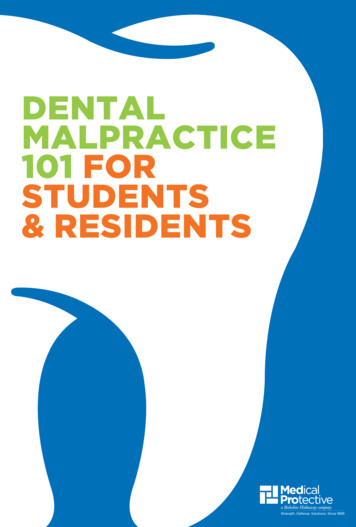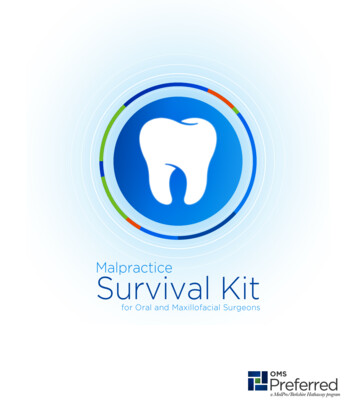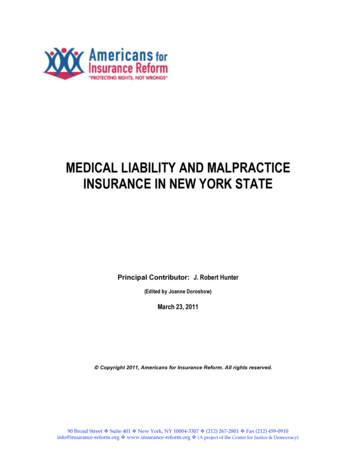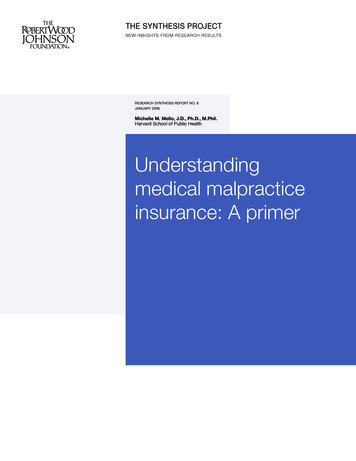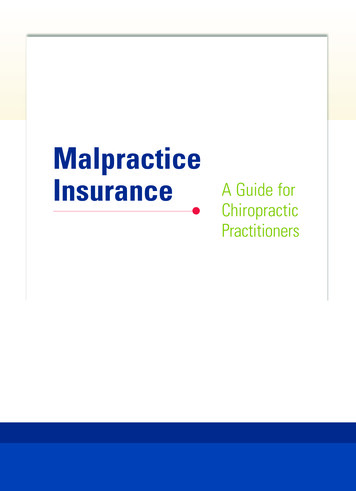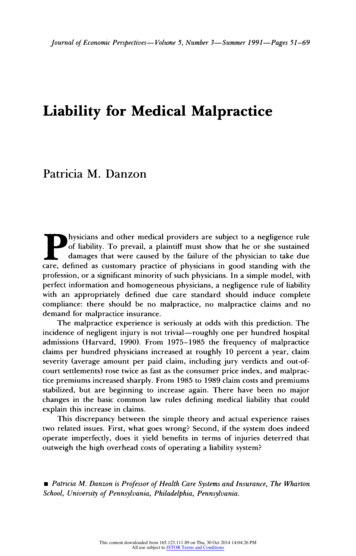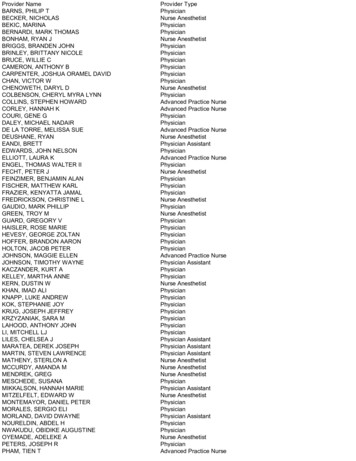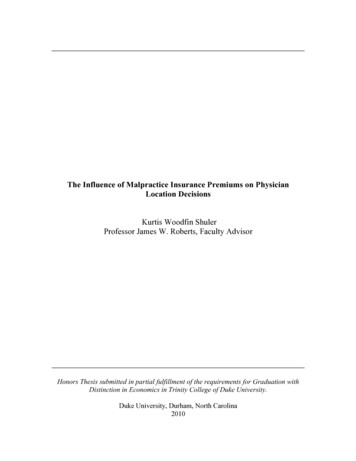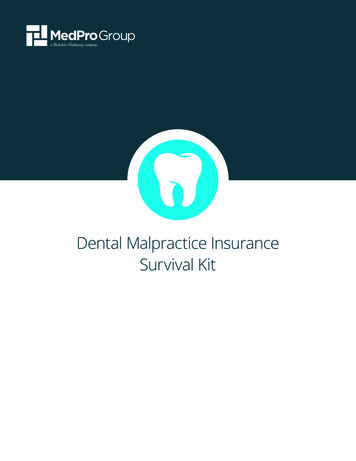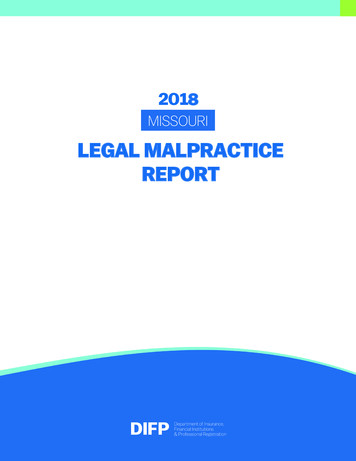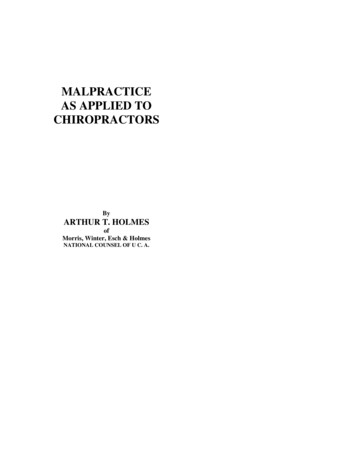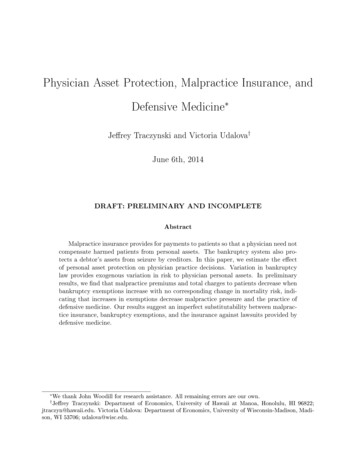
Transcription
Physician Asset Protection, Malpractice Insurance, and Defensive MedicineJe rey Traczynski and Victoria Udalova†June 6th, 2014DRAFT: PRELIMINARY AND INCOMPLETEAbstractMalpractice insurance provides for payments to patients so that a physician need notcompensate harmed patients from personal assets. The bankruptcy system also protects a debtor's assets from seizure by creditors. In this paper, we estimate the e ectof personal asset protection on physician practice decisions. Variation in bankruptcylaw provides exogenous variation in risk to physician personal assets. In preliminaryresults, we nd that malpractice premiums and total charges to patients decrease whenbankruptcy exemptions increase with no corresponding change in mortality risk, indicating that increases in exemptions decrease malpractice pressure and the practice ofdefensive medicine. Our results suggest an imperfect substitutability between malpractice insurance, bankruptcy exemptions, and the insurance against lawsuits provided bydefensive medicine. We thank John Woodill for research assistance. All remaining errors are our own.†Je rey Traczynski:Department of Economics, University of Hawaii at Manoa, Honolulu, HI 96822;jtraczyn@hawaii.edu. Victoria Udalova: Department of Economics, University of Wisconsin-Madison, Madison, WI 53706; udalova@wisc.edu.
1IntroductionIn a seminal contribution, Kessler and McClellan (1996) show that the medical malpractice liability system impacts physician practice decisions.Defensive medicine, or medicaldecisions made to protect physicians from lawsuits rather than to bene t patients, increasesmedical costs without improving health outcomes. Kessler and McClellan (1996) estimatethe e ect of tort reforms on practice decisions, nding that reductions in liability costs forphysicians lead to less defensive medicine and lower costs. Currie and MacLeod (2008) consider a variety of other legal liability reforms, nding a decrease in defensive medicine fromjoint and several liability reforms that result in doctors being more likely to be sued directlyby injured patients and an increase in procedure use from tort reforms that limit damagespayable to patients.Papers examining defensive medicine and physician malpractice liability have generally argued that physicians face little nancial risk from malpractice claims (Currie andMacLeod, 2008, p.799).Silver et al. (2008) show that many malpractice judgments arefor amounts just under the limit of a physician's insurance for a single claim. There is alsoagreement that the indirect costs to a physician of defending against malpractice suits, including lost time and energy, can be signi cant (OTA, 1993). Seabury et al. (2013) showthat physicians can spend up to 11% of their careers with an open, unresolved malpracticeclaim, while Jena et al. (2011) show that 55% of physicians in internal medicine, 80% ofgeneral surgeons, and 74% of obstetricians/gynecologists face a malpractice claim at leastonce by age 45. Involvement in a malpractice case can produce lasting harm to a physician'scareer through the National Practitioners' Data Bank, a searchable database that includes1records of any payments made in response to malpractice suits.1 The National Practitioners' Data Bank (NPDB) maintains records of any payments made by or onbehalf of a physician settling a malpractice claim and can be referenced by future employers, state licensingboards, or lawyers for plainti s. outUs.jspformore details. The harm of being listed in the NPDB is evidenced by employers of physicians o ering to paymalpractice settlements under the condition that the physician be dropped from the lawsuit. This corporateshield results in approximately 20% of all malpractice payments going unreported in the NPDB (Chandraet al., 2005).1
However, there is empirical evidence that physicians' personal assets are not always protected from malpractice claims. The Harvard Medical Practice Study shows that approximately 6-9% of physicians facing a malpractice claim pay out of pocket costs, includingjudgment and legal defense costs, while over 85% report lost income from time spent contributing to legal defense. The study concludes that monetary sanctions are real for physicians (Lawthers et al., 1992, p.476).Lawthers et al. (1992) also show that physicians'subjective estimates of the probability of being sued are three times greater than the actualprobability of being sued across all cases and more thanthirtytimes greater in cases involv-ing injury due to physician negligence, a disparity also found in Jena et al. (2011).2Thelow probability of an injured patient ling a lawsuit implies that there may be many injuredpatients who have not yet led suit against a physician but might at any time, resulting in ahighly unpredictable number of claims in a given year that could exhaust a physician's malpractice insurance. Studdert et al. (2004, p. 285) discuss how a huge reservoir of injuries has led to yearly variance in the number of malpractice lawsuits since the 1960s.Thus,physicians may perceive a large threat to their personal assets from malpractice litigation,leading to a behavioral response when this threat is increased or reduced.We analyze the e ects of changes in the level of personal asset protection for physicianson medical practice.To determine the extent to which a physician's personal assets arebeyond the reach of plainti 's lawyers, we consider the asset protections available throughthe bankruptcy system. A primary bene t of ling for bankruptcy is receiving a dischargeof debts, a legal ruling that prevents creditors from collecting on those debts so that thedebtor need not pay them back. The Supreme Court's ruling in the 1998 case ofv. GeigerKawaauhauestablished that physician debts from malpractice cases are eligible for a dischargein bankruptcy.Both Chapter 7 and Chapter 13 personal bankruptcy o er debtors theopportunity to discharge debts while retaining some assets. These assets must have valuelower than predetermined exemption levels. The value of property that may be held exempt2 Physicians estimated the probability of a lawsuit being led at 60%, while the actual likelihood is under2% (Localio et al., 1991).2
from creditors is determined by each state, and exemption levels vary both across states andover time. The purpose of exemptions is to assist a debtor's fresh start after bankruptcy,so exemption levels are a good measure of the amount of insurance the bankruptcy systemo ers against negative wealth shocks.We rst show that changes in bankruptcy exemptions a ect the malpractice insurancemarket, establishing the rst link between personal asset protection and malpractice concerns. We draw intuition from a simple model of demand and supply of malpractice insurance.Since both malpractice insurance and bankruptcy exemptions protect a physician'spersonal assets in case of a lawsuit, these goods are likely substitutes. We expect that whenstates increase bankruptcy exemption levels and thereby provide physicians with more insurance against lawsuits, physicians will have lower demand for malpractice insurance. Thismodel has the testable implication that the price of malpractice insurance should fall whenbankruptcy exemptions rise.We then turn to whether changes in personal asset protection lead to changes in medicalpractice.A large bankruptcy exemption can reduce the probability of an injured patientling a lawsuit by reducing the amount that the physician would pay after judgment. Thisis similar to the e ect of a tort reform that limits the damages that may be collected, withthe important di erence that changes in bankruptcy exemptions immediately a ect payoutsin all possible malpractice cases against a physician, not only those where the injury occursafter the law change. Currie and MacLeod (2008) note that the time between an injury to apatient and the payment of a settlement is around six years, confounding empirical work onthe e ect of tort reforms on physician behavior due to uncertainty in the lag structure of thee ects. The immediate e ect of changes in bankruptcy laws allows us to be more con dentin the causal interpretation of our ndings.Similar to Kessler and McClellan (1996), wend that increased exemption levels lead to reductions in total charges for hospitalizedpatients with heart attacks with minimal impact on mortality. We interpret this result asevidence of a decrease in defensive medicine when physicians have more wealth insurance3
from the bankruptcy system. However, we also nd an increase in procedure utilization ratesfor Medicare patients, suggesting that physicians respond on several margins to changes inliability pressure. This paper is the rst to show that changes in physician personal assetprotections a ect the practice of medicine through the malpractice system.2Background2.1Dischargeability of Malpractice DebtsBankruptcy law prohibits the discharge of debts that are a result of willful and malicious3injury by the debtor.The rst case to test the meaning of this phrase came shortly afterthe passage of the Bankruptcy Act of 1898. In 1904, the Supreme Court ruled inColwellTinker v.that a willful disregard of what one knows to be his duty, an act . . . wrongful inand of itself, and which necessarily causes injury and is done intentionally met the standard4to be nondischargeable in bankruptcy.Under theTinkerstandard, a physician could notdischarge malpractice debts if the resulting injury was considered a likely consequence of thephysician's actions or caused by negligence.Tinkerwas a key precedent in bankruptcy law until the Bankruptcy Reform Act of1978 (BRA78), in which Congress declared that the word willful must mean deliberateor intentional, overrulingTinkerby negligence to be discharged.5and making it easier for debts incurred for harms causedAfter BRA78, federal Courts of Appeals divided over theproper interpretation of the new law. The First, Second, Fifth, Sixth, Ninth, and Tenth Circuits ruled debts arising from negligent behavior nondischargeable in bankruptcy. However,the Third and Eleventh Circuits adopted a stricter standard, requiring that in order for a3 11 U.S.C. 523(a)(6), 20054 Tinker v. Colwell, 193 U.S. 473 (1904), p. 4875 House Report 95-595 (1978): Paragraph (6) excepts debts for willful and malicious injury by the debtorto another person. Under this paragraph, 'willful' means deliberate or intentional. To the extent that Tinkerv. Colwell [citation deleted] held that a looser standard is intended, and to the extent that other cases haverelied on Tinker to apply a 'reckless disregard' standard, they are overruled. 4
debt to be nondischargeable, a reasonable person should have been able to predict that the6action would cause harm.In 1998, the Supreme Court resolved the con icting rulings inKawaauhau v. Geiger, a case surrounding a physician using bankruptcy to discharge a medical malpractice debt. A unanimous Supreme Court upheld the Eighth Circuit's ruling that debts arising from recklessly or negligently in icted injuries are dischargeable in bankruptcy7and only acts done with the actual intent to cause injury are nondischargeable.As such,any medical malpractice debt where the injured patient cannot show that the physician intended to cause harm is dischargeable in bankruptcy. We use the pre-Geigerdi erences infederal appeals court rulings to test the relationship between bankruptcy exemption levelsand physician practice decisions.2.2Bankruptcy and ExemptionsChapter 7 and Chapter 13 are the two primary types of personal bankruptcy.Chapter 7o ers debtors a complete discharge of debts, but all assets above the available exemptionlevels can be seized to pay o creditors. Chapter 13 allows debtors to keep more of theirassets, but they must agree to a repayment plan to make partial payment of their debtsfrom future income. Only after successfully completing this plan by making payments overseveral years is a debtor eligible for a discharge of the remaining debt.Exemptions are available for a wide variety of assets. The homestead exemption, whichallows debtors to retain housing equity, is the largest exemption in most states.Otherexemptions shield cars, clothing, or tools of trade from creditors, as long as the value of theasset is below a speci c dollar amount. Some states use personal property exemptions thatallow debtors to choose any property of total value less than the exemption level, rather thano ering individual exemptions for di erent types of assets.In addition to the changes mentioned above, BRA78 established a national set of bankruptcy6 See Hayes (1997) for speci c cases and analysis of rulings. Figure 1 shows the geographic boundaries ofthe federal Courts of Appeals.7 Kawaauhauv. Geiger, 523 U.S. 57 (1998), p. 61-64.5
exemptions. BRA78 permitted states to set their own exemption levels and every state didso by 1987, though some states allow debtors to claim the federal exemptions in lieu of stateexemptions.We address issues with the determinants of state exemption levels and theexogeneity of changes in exemption levels in our empirical work below.In 2005, Congress passed the Bankruptcy Abuse Prevention and Consumer ProtectionAct (BAPCPA), changing the nature of personal bankruptcy by adding a means test designedto prevent individuals with high incomes from ling for Chapter 7 bankruptcy.However,the means test applies only to individuals whose debts are primarily consumer debts, suggesting that a physician with malpractice debts that constituted the majority of theindividual's overall debt would not be subject to the means test.8Thus, BAPCPA did notgreatly a ect the ability of physicians to use the bankruptcy system to discharge malpracticedebts unless their consumer debts are larger in magnitude than their malpractice debts.3Empirical Model and DataAs a baseline, we estimate the statistical modelYist α β · T otalExemptionst π · Xist µt ηs ζs · T rend istwheresYis our dependent variable of interest measured in county or individualand year 10,000,Xt, T otalExemption(1)iin stateis the sum of all available exemptions measured in units ofis other control variables,µandηare year and state xed e ects, andT rendisa set of state speci c linear trends.Identi cation of the e ect of the bankruptcy exemption levels comes from variation withinstates over time. For our research design to produce causal estimates of the e ect of changes8 11 U.S.C. 707(b)(1), 2005. For interpretation of the clause, see Wedo (2005) andNo.06-21356 (Bankr.E.D. Wis, 2006) (unpublished decision available atgov/opinions/files/pdfs/In Re Kinnee, 06-21356.pdf).In re Kinnee asserts that an individual hasprimarily consumer debt if more than 50% of the total debt amount is consumer debt.6In re Kinnee, Casehttp://www.wieb.uscourts.
in bankruptcy exemption levels on malpractice premiums or medical practice decisions, thevariation over time in exemption levels must be exogenous. Hynes et al. (2004, p. 31) examine potential determinants of state exemption levels from 1975-96, including the numberof doctors per resident and bankruptcy ling rate, and nd that the only robust predictorof exemption levels .was historic levels of exemptions. Mahoney (2012) nds thathealth policy variables, including the share of individuals with health insurance, also do notexplain variation in bankruptcy exemptions. Fay et al. (2002, p. 709) argue that exemption levels should be treated as exogenous with respect to bankruptcy ling rates because states change their exemption levels only rarely - mainly to correct nominal exemption levels for in ation. The claim that in ation adjustments are a factor in exemption changes issupported by historical work in Skeel (2001). This intuition also applies for why exemptionlevels can be considered exogenous with respect to malpractice premiums or medical practicedecisions. Over 1989-2005, there were a total of 112 changes in the nominal total value ofstate exemption levels for an average of 6.6 changes per year. Since it does not appear thatexemption levels are determined by factors related to malpractice premiums, health careprovision, or state health care policy, nor jointly through a third factor such as bankruptcylings per capita, we treat changes in exemption levels as exogenous.Our data on exemptions comes from Traczynski (2011). We obtain data on state bankruptcyexemption levels from state statutes for the years 1989-2005 and report values in Table 1.The homestead exemption is the amount available in each year, ignoring any restrictionson lot size or location of the homestead.This amount is unlimited in some states.Weconstruct the total nonhome exemption level by adding together all allowable exemptionsfor cars, personal possessions, tools of trade, bank deposits, and wildcard exemptions. Weomit explicit exemption amounts for clothing or household goods, insurance payouts, burialplots, or pensions. These items are not subject to value limits in many states or have speci cbene ciary requirements and therefore do not have easily quanti able changes in their valueover time. Gropp et al. (1997) and Berkowitz and Hynes (1999) use a similar de nition of7
nonhome exemptions. We adjust all exemptions into constant 2007 dollars using the CPI.In states that allow debtors to choose between using state exemptions and federal exemptions, we assume that individuals choose the set of exemptions with the higher total value(homestead plus nonhome).For states with unlimited homestead exemptions, we assigna nominal value of 500,000 to the homestead exemption, consistent with Berkowitz andHynes (1999).OurT otalExemptionmeasure is the sum of the homestead and nonhomeexemptions, which re ects the assumption that debtors can move assets between exemptioncategories to maximize the value of the exemptions. This pre-bankruptcy planning is generally permitted by bankruptcy judges, though after BAPCPA, such planning must take placeearlier relative to the date of ling.9As shown in Table 1, the nominal and real values ofbankruptcy exemptions are increasing in most states over this period.We obtain data on malpractice insurance premiums from an annual survey conducted bythe Medical Liability Monitor (MLM) from 1991-2012. The MLM conducts an annual stateby-state survey of medical liability insurance carriers comprising approximately 65-75% ofthe total medical malpractice market to obtain data on premiums for mature claims-madeinsurance policies with limits of 1 million per claim and 3 million in total coverage per10year.The insurance carriers surveyed by the MLM report that policies with these limits arethe most commonly purchased policies. The premium data are reported for three physicianspecialties: internal medicine, general surgery and obstetrics-gynecology.Every companyparticipating in the survey provides rates for each state and sub-state area in which it writesinsurance policies. The most common sub-state areas are counties, though several companiesreport rates for MSAs or regions of the state. In cases where rates for MSAs or regions of9 For a discussion of changes made by BAPCPA in laws surrounding transfers, see Gallagher (2011).10 Under a claims-made policy, a physician is insured against any claims made during the term of theinsurance policy, if the incident occurred anytime after the start of the policy. Tail coverage is needed tocover incidents that are reported after the policy lapses, even if the alleged malpractice occurs while thepolicy is in e ect. In contrast, under a policy written on an occurrence basis, a physician is insured for anyincidents that occur during the term of the insurance regardless of when those claims are reported. No tailcoverage is needed because incidents that occurred during the policy period are covered no matter how muchlater they are reported.8
the state were provided, we apply those rates to the appropriate counties.11We then createcounty average rates by taking the mean of the reported company rates for that county andconvert all premiums into 2007 dollars using the CPI. In some cases, the data contain rates forpolicies with limits other than 1 million/ 3 million or for policies written on an occurrencebasis. We examine the sensitivity of our results to the inclusion of these alternative rates inthe county averages in our empirical work below.States with government-run patient compensation funds (PCFs) are also included in thesurvey. In these states, the required coverage limits usually di er from 1 million/ 3 millionlimits. Physicians can buy a basic coverage with the required limits plus pay a surchargethat varies in size from a modest percentage of the basic coverage premium to more thanthe cost of the basic coverage. Since premium changes in states with PCFs can sometimesoccur due to the legislative changes of required minimum coverage limits, we examine PCFstates separately in our empirical work.We have dropped some observations from the nal dataset. First, we explore the sensitivity of our results to dropping observations for policies with limits other than 1 million/ 3million or policies for occurrence coverage because we believe the rates for these policies maybe systematically di erent from the 1 million/ 3 million claims-made policies. Second, wedrop observations without enough geographic detail to assign the reported rate to a county.Third, we drop reports in which ranges of rates were provided, either territorial or for classesof doctors within a specialty. Finally, we drop premium data for fund non-participants instates with voluntary participation in the PCF, keeping only rates that fund participants facein the PCF state. Additionally, since each report provides data for the current year and forthe previous year, we use data from future reports to populate missing values for companiesthat do not report rates in the current report. We weight our nal premium data to accountfor geographic distribution of physicians in the state using data on the number of non-federaltotal patient care physicians by county from the 2012-2013 AHRF Access Database based11 In the few cases where a company provides two di erent rates for the same county, we average them.9
12on the AMA Master File data.To explore physician treatment choices, we use the Nationwide Inpatient Sample (NIS)from 1998 to 2005. The NIS tracks hospital inpatient stays across most of the U.S., and each13year of data represents a 20% sample of U.S. hospitals.NIS data is at a discharge level,reporting speci c medical conditions and the total hospital charges along with demographiccharacteristics. We limit the data to hospital stays where the patient's primary diagnosisis either an acute myocardial infarction (AMI) or ischemic heart disease (IHD). AMI is amore severe heart illness than IHD, and both are caused by the narrowing of arteries andrestriction of blood ow around the heart. AMI and IHD are the current leading cause ofdeath worldwide and the leading cause of hospitalizations in the U.S.14Kessler and McClel-lan (1996) study defensive medicine in the treatment of these two diseases among Medicarepatients, though our sample includes a wider variety of ages and insurance coverages. Focusing on AMI and IHD allows us to compare our results across diseases of di erent severity andfacilities comparison between our estimated e ects of personal asset protection on defensivemedicine and the e ects of tort reforms found in Kessler and McClellan (1996).As measures of procedure utilization, we use rates of cesarean section births from VitalStatistics Natality Birth Data Files over the period 1989-2004. Following Yang et al. (2009),we calculate the number of all births that are vaginal births after the mother had a previouscesarean section (VBAC) and the total number of cesarean section births. We then determinethe percentage of total births in a county that t each of these de nitions, treating remainderof state as a single additional county. We obtain data on rates of usage per 1000 Medicareenrollees for a number of procedures from the Dartmouth Atlas of Health Care at the hospitalreferral region level for the period 1992-2005. Hospital referral regions are geographic areasde ned by where residents most often go for major procedures such as heart or brain surgery.The U.S. is divided into 306 hospital referral regions, making the areas smaller than a state12 A couple of years had physician data missing (1991 and 2009).interpolation.13 As of 2011, 46 states provide data to the NIS.14 See Finegold et al. (2013) and AHA (2012).10We populate these years by linear
and larger than a county. In cases where the region runs over state boundaries, we assignthe exemption level of the state in which the referred hospital is located. The procedureswe use are coronary angiography, coronary artery bypass grafting (CABG), percutaneouscoronary intervention, transurethral prostatectomy, radical prostatectomy, and all surgeries.These speci c procedures o er physicians some latitude in deciding whether to use them ona given patient and were measures of defensive medicine in Baicker and Chandra (2005).Table 2 presents summary statistics for our data.4Preliminary Results4.1Malpractice PremiumsWe rst look for evidence that higher bankruptcy exemption levels are a substitute for theasset protection o ered by malpractice insurance. We use county average malpractice premiums in states without patient compensation funds as the dependent variable in Equation (1)and present results in Table 3 for a panel of counties from 1991-2005. County level regressionsare weighted by the number of physicians working in patient care in each county-year.Our results show a consistently negative e ect of exemptions on prices across specialtiesand across di erent de nitions of the average rate in a county. When including all rates inthe county average in column (1), we nd that a 10,000 increase in bankruptcy exemptionlevels leads to a decrease of 101 in the average malpractice premium for physicians practicing internal medicine, a decrease of 407 for general surgeons, and a decrease of 576 forobstetrician-gynecologists. Using all rates may not be appropriate if policies with di erentlimits or occurrence policies have di erent changes in their premiums in response to an increase in exemptions. We present results that include only prices of claims-made policies oronly prices of policies with limits of 1 million/ 3 million or both in columns (2), (3), and (4)respectively. None of the estimates under these alternative de nitions of the average countyrate lie outside the 95% con dence interval of the estimates from column (1), though for11
internal medicine, some of the negative e ects are statistically indistinguishable from 0 dueto imprecise estimates. Overall, the e ect of exemptions on malpractice premiums appearsto be stable across di erent measures of the average premium.Table 4 shows how the changes in exemption levels have impacted the malpractice premiums paid by each of the three physician types over the sample period. The mean total exemption is the physician-weighted average exemption level in each year, ranging from 122,838in 1991 to 142,976 in 2005. We use the estimates in Table 3 to determine how the changesin exemption levels would a ect malpractice premiums in each year. These results show thatif a state increased its bankruptcy exemption levels from 122,838 to 142,976, malpracticepremiums for physicians in internal medicine would decrease by 204, for general surgeonsby 820, and for obstetrician-gynecologists by 1160. In 2005, the physician-weighted meanmalpractice premium for these three groups of physicians was 20,317, 69,589, and 100,800,respectively, so the decreases in premiums associated with increases in exemption levels account for 1.01%, 1.18%, and 1.15% of the mean for each group.To further establish the causal relationship between increases in exemption levels anddecreases in malpractice premiums, we now turn to the question of that channel throughwhich exemption levels a ect malpractice premiums. The history of di ering federal Courtof Appeals rulings on the dischargeability of malpractice debts in bankruptcy provides atest of whether dischargeability is the channel through which exemptions a ect malpracticepremiums. Using the analysis of rulings in Hayes (1997), we categorize Courts of Appealsas having a strict reading of the willful and malicious injury clause, which would permitdischarging medical malpractice debts due to negligence, or a loose reading, which doesnot permit discharging debts due to negligence.This categorization is based on rulingsmade prior to the 1998 Supreme Court ruling in theGeigercase.We consider the First,Second, Fifth, Sixth, Ninth, and Tenth Circuits to adopt a loose reading, while the Third,15Eighth, and Eleventh Circuits adopt a strict reading.Since the Supreme Court's ruling in15 We discard states in the Fourth, Seventh, and DC Circuits in this analysis as there are few changes inbankruptcy exemption levels in the states without patient compensation funds in these Circuits, leading to12
Geigerforced all Circuits to use a strict interpretation of the clause after 1998, we expectthat the relationship between exemption levels and malpractice premiums in Circuits withstrict interpretations will change less after 1998 than in Circuits with a loose interpretation.We also expect that the relationship between exemptions and malpractice premiums willbe weaker pre-Geigerin Circuits with loose interpretations than in Circuits with strictinterpretations.We modify Equation (1) to include interaction terms between the bankruptcy exemption level in a state, the strict or loose interpretation variable, and a dummy for the yearsafter th
Papers examining defensive medicine and physician malpractice liability have gener-ally argued that physicians face little nancial risk from malpractice claims (Currie and MacLeod, 2008, p. 799). Silver et al. (2008) show that many malpractice judgments are for amounts just under the limit of a physician's insurance for a single claim. There is .
